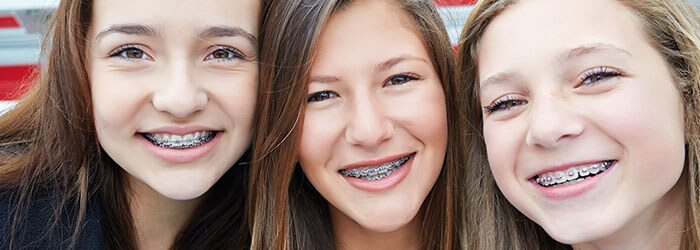One question that many people, especially parents, face is at what is the best age for braces? Get them too early and further treatment might be required later in life; get them too late and they may need to be worn for a longer period of time or cause additional problems for the already angst-ridden teenage years.
There’s no universal right answer to this question, but we can draw from our years of experience to provide some advice on factors to consider when deciding the best age for braces.
Early Intervention: Ages 7-9
We recommend having a child evaluated for braces as early as age 7. This does not mean that braces will be applied that early, but it can give you a roadmap of what future treatment might look like.
By age 7, most baby teeth have started to come out and an orthodontist can get a good sense of what the alignment of permanent teeth will look like. In some cases, braces or partial teeth aligners may be applied at this stage if a child is having difficulty talking or eating due to poor teeth alignment.
A child is also a candidate for early braces if he or she has protruding teeth, a crossbite, or tooth crowding. Catching and treating these symptoms early can prevent them from becoming worse as more permanent teeth arrive.
If your child needs braces at an early age, be prepared to help him or her take care of them. Wearing braces can provide a valuable lesson in self-care, but may require additional intervention until good habits are formed.
Prime Treatment Time: Ages 10-14
Most children who receive braces begin treatment between the ages of 10 and 14. At this age, baby teeth have completely fallen out and the jaw is stable enough to support long-term orthodontic treatment.
Braces come in several varieties from traditional metal brackets to ceramics and invisible aligners. What used to be a stigma about wearing braces has largely been eliminated due to the prevalence of braces among adolescents, but it is important to talk with your child about the changes to his or her appearance that will come as a result of wearing braces.
Unlike young children, teens and pre-teens should be mature and responsible enough to manage braces on their own with little parental intervention. The average time for wearing braces at this age is one and a half to two years.
Once braces come off, a retainer will likely be needed to keep teeth in their correct alignment and prevent additional treatment later on.
Older Options: Ages 14+
Contrary to what you might think, you are never too old for braces! Many adults do not have access to orthodontics as kids or delay getting braces for other reasons.
Think of teeth the way you would any other bone on your body. They do stop growing at the end of adolescence, but it’s still possible to correct them throughout your life. If your arm breaks, it can heal and be put back into place with a cast. Teeth are no different.
As an adult, you likely already have an established routine that will need to modified to account for braces. You may need to alter your diet, your morning and evening schedules, or even some of the activities you do.
No matter what changes you need to make, keep in mind that they are short-term sacrifices for long-term gains in confidence and dental health. Wearing braces for a few years can save you from more serious dental issues down the road.
Free Orthodontic Consultation
In the end, the best way to know the best age for braces is to receive a professional evaluation from an board-certified orthodontist.. If you live in the city or suburbs of Fresno, CA, call us today to schedule your free consultation.


